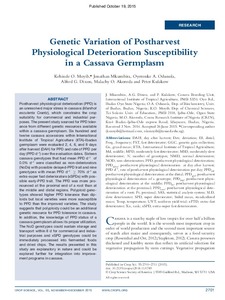| dc.contributor.author | Moyib, K.O. |
| dc.contributor.author | Mkumbira, J. |
| dc.contributor.author | Odunola, O. |
| dc.contributor.author | Dixon, A. |
| dc.contributor.author | Akoroda, M.O. |
| dc.contributor.author | Kulakow, P.A. |
| dc.date.accessioned | 2019-12-04T10:58:13Z |
| dc.date.available | 2019-12-04T10:58:13Z |
| dc.date.issued | 2015-10-19 |
| dc.identifier.citation | Moyib, K.O., Mkumbira, J., Odunola, O.A., Dixon, A.G., Akoroda, M.O. & Kulakow, P. (2015). Genetic variation of postharvest physiological deterioration susceptibility in a cassava germplasm. Crop Science, 55(6), 2701-2711. |
| dc.identifier.issn | 0011-183X |
| dc.identifier.uri | https://hdl.handle.net/20.500.12478/943 |
| dc.description.abstract | Postharvest physiological deterioration (PPD) is an unresolved major stress in cassava (Manihot esculenta Crantz), which constrains the crop suitability for commercial and industrial purposes. The present study sourced for PPD tolerance from different genetic resources available within a cassava germplasm. Six hundred and twelve cassava accessions within International Institute of Tropical Agriculture (IITA)-Ibadan germplasm were evaluated 2, 4, 6, and 8 days after harvest (DAH) for PPD and rate of PPD per day (PPD d–1) over the evaluation dates. Sixteen cassava genotypes that had mean PPD d–1 of 0.0% d–1 were classified as non-deteriorators (NoDs) with possible delayed-PPD trait and nine genotypes with mean PPD d–1 ≥ 70% d–1 as extra-super fast deteriorators (xSPDs) with possible early-PPD trait. The PPD was more pronounced at the proximal end of a root than at the middle and distal regions. Polyploid genotypes showed higher PPD tolerance than diploids but local varieties were more susceptible to PPD than the improved varieties. The study suggests that polyploidy could be an additional genetic resource for PPD tolerance in cassava. In addition, the knowledge of PPD status of a cassava germplasm allows its proper utilization. The NoD genotypes could sustain storage and transport within 8 d for commercial and industrial purposes and xSPD genotypes could be immediately processed into fermented foods and dried chips. The results presented in this study are explanatory in nature and could be explored further for integration into improvement programs in cassava. |
| dc.format.extent | 2701-2711 |
| dc.language.iso | en |
| dc.subject | Cassava |
| dc.subject | Genotypes |
| dc.subject | Polyploid |
| dc.subject | Postharvest Physiology |
| dc.subject | Manihot Esculenta |
| dc.title | Genetic variation of postharvest physiological deterioration susceptibility in a cassava germplasm |
| dc.type | Journal Article |
| dc.description.version | Peer Review |
| cg.contributor.crp | Roots, Tubers and Bananas |
| cg.contributor.affiliation | Tai Solarin University of Education |
| cg.contributor.affiliation | International Institute of Tropical Agriculture |
| cg.contributor.affiliation | University of Ibadan |
| cg.contributor.affiliation | Cocoa Research Institute of Nigeria |
| cg.coverage.region | Africa |
| cg.coverage.region | West Africa |
| cg.coverage.country | Nigeria |
| cg.isijournal | ISI Journal |
| cg.authorship.types | CGIAR and developing country institute |
| cg.iitasubject | Cassava |
| cg.journal | Crop Science |
| cg.howpublished | Formally Published |
| cg.accessibilitystatus | Limited Access |
| local.dspaceid | 76468 |
| cg.targetaudience | Scientists |
| cg.identifier.doi | https://dx.doi.org/10.2135/cropsci2014.11.0749 |

